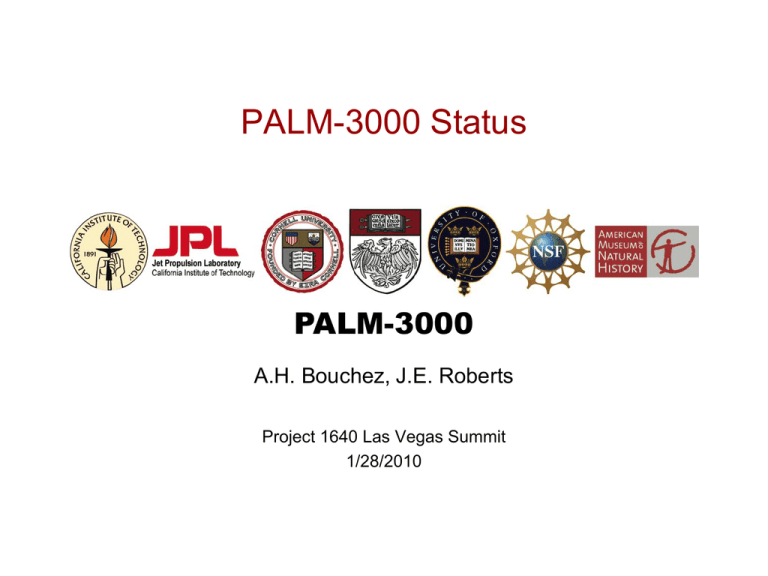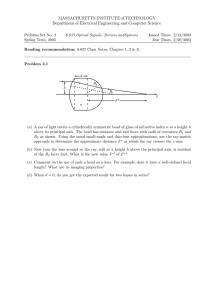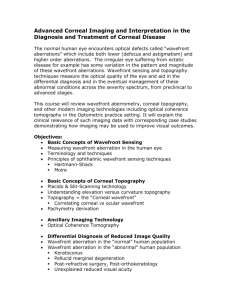PALM-3000 Status PALM-3000 A.H. Bouchez, J.E. Roberts Project 1640 Las Vegas Summit
advertisement

PALM-3000 Status PALM-3000 A.H. Bouchez, J.E. Roberts Project 1640 Las Vegas Summit 1/28/2010 PALM-3000 PALM-3000 status The big picture: We are integrating the new PALM-3000 components in the lab, while a few remaining subsystems are in detailed design. We are on track for a pre-ship review in early July. Talk Outline: • Status by subsystem – 3388-actuator DM testing results • Integration and testing in 2010 • Commissioning plans in 2011 2 Optical Bench PALM-3000 DM3388 OAP1 TTM • • • Detailed design of all optomechanics is complete Currently verifying global flexure of bench with science instrumentScience Instrument RemainingVolume design tasks: – – – – Stimulus fold mirror Enclosure Cable routing Cable interface boxes OAP2 DM241 FM1 FM3 SSM2 FM2 SSM1 FM4 HOWFS & ACam PALM-3000 • • High-Order Deformable Mirror Received at Caltech on Dec. 4, 2009 Spent Dec-Jan. testing performance with a Zygo interferometer In the lab at Caltech Prior to face sheet bonding (Xinetics Inc.) PALM-3000 HODM testing • Tested with a Zygo in I&T testbed – Plastic curtains enclose bench to allow humidity control with dessicant • Data – Unpowered and bias voltage measurements at 40-50% RH, 1015% RH and 20-30% RH – Actuator influence functions – Actuator Linearity – Actuator Hysteresis – Actuator Creep • Reconstructor made from the influence functions was used to flatten the mirror – Other control tests include controlling to the low spatial frequency error instead of flat and maximizing the focus error to test the full mirror stroke HODM Control Result PALM-3000 Surface Surface • Mirror in normal mode (40V bias) Temp: 75F RH: 26% • Zernikes 1-30 were removed from the bias measurement and the residual wavefront was flattened using the HODM actuators. The result is on the left. • On the right is the same measurement less Zernikes 1-30. This is what we can expect to achieve when the LODM is correcting the low-spatial-frequency errors PALM-3000 HODM lessons • The HODM can be flattened to 10nm RMS – Simulations show that resulting wavefront will not limit contrast performance • The total stroke of the mirror is 1.06μm. – A few actuators along the bottom of the mirror have significantly lower stroke • With the LODM, the HODM will use 30% of its stroke to correct its own figure • We need to control the humidity around the HODM – Best figure between 20% and 30% RH • 40V bias rather than the nominal 50V bias gives more stroke and a better base figure at the expense of more non-linearity in the actuator gains PALM-3000 45% RH 74deg Humidity Results 30% RH 74deg 13% RH 70deg • Unpowered surface figure at different humidities shows the effect of humidity on the puckers • Ideal humidity is between 13% and 30% PALM-3000 • Complete and ready for installation in lab testbed • Flexure testing ongoing. Initial results meet requirements (<0.2”/hr) • Two optics need to be replaced: Will replace and realign later in spring • Acquisition camera (not shown) needs to be aligned and tested High Order Wavefront Sensor Pupil RMS slope RMS wavefront sampling (pixels) (nm; Zernike 1-20) 63 0.038 102 32 0.066 166 16 0.150 143 8 0.175 150 Meets requirements (<0.05 binned pixels) See Baranec, Proc. SPIE 7015, 2008. PALM-3000 Microlens arrays imaged with a CMOS alignment camera HOWFS Detail Shack-Hartmann spots imaged with the CCD-50 Electronics Overview PALM-3000 Legend: Fiber, high-speed switch, ethernet, AO bench cables Ethernet Pvt net Fiber Splitter User Workstation (Data Room) AO Bench Wavefront Processor (computer room) DM Racks (Cass cage pos. 2 & 3) Controller Racks (Cass cage pos. 4 & 5) PALM-3000 • • DM Electronics and Cabling Lab configuration complete and in use (serial com. to DM drivers, 99 cables, air cooled) Current design efforts: - High-speed DM command electronics design in progress - Operational DM cable design in progress (16 cables for HODM, 1 for LODM) - Driver electronics dissipate ~6 kW. Liquid cooling design still required PALM-3000 • • • • Wavefront Processor Computer Wavefront Processor Computer clusters completed and deployed (JPL and Caltech) Significant challenge has been hardware/software compatibility. Manufacturer of high-speed switch went out of business. Have demonstrated full vector matrix multiplication using 64x64 subapertures at 1.24 kHz with current GPUs If necessary, will upgrade to latest GPUs after pre-ship review to meet 2 kHz requirement PALM-3000 Software Deep into coding & verifying interfaces. Expect to begin using software environment in the lab in Feb. Major components Complete Publish/subscribe infrastructure 100% • Command parser – • • • • % 95% Includes communications interfaces Wavefront processor Device drivers (hardware interfaces) Telemetry system Automations 30% 75% 50% 25% 14 PALM-3000 • Flexible servo control scheme. • Detailed design of N=64 mode complete • Detailed design of other modes still in progress Servo Control PALM-3000 Palomar Infrastructure Currently defining requirements. Major components: • Power at Cassegrain focus (& AO lab) • Coolant at Cassegrain focus (& AO lab) • Telescope balance adjustments Power in computer room Communications between Cass, Computer Room, AO lab, and Data Room 16 PALM-3000 PALM-3000 Testbed • Includes HODM, HOWFS, WFP computer, and 3 calibration/diagnostic sensors • Will allow us to verify all electronic & software interfaces. HODM WFP computer CMOS Zygo HOWFS & ACAM HASO 17 PALM-3000 Lab I&T Schedule Testbed activities Dec-Jan Verify performance of HODM Feb-Mar Verify performance of HOWFS Mar-Apr Test wavefront processor, software environment May-Jun Verify high-speed wavefront control performance Jul SPIE meeting, pre-ship review 18 PALM-3000 PALM-3000 Schedule Overview 19


